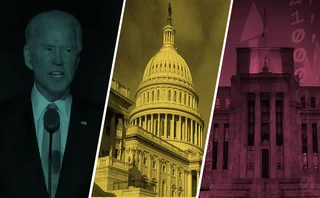
Variation margin, ETFs and the costs of European Isins
The week on Risk.net, November 17–24, 2017

EBA and Eiopa confirm changes to VM rule for forwards
Bodies aim to align EU with other jurisdictions – hinting at end of unpopular rule
ETFs under scrutiny over liquidity risk
Secondary market trading in funds could freeze up in times of stress, supervisors fear
Hostage situation: venues slam cost of European Isin utility
Trading venues bemoan commercial terms of service vital to Mifid II swaps reporting
COMMENTARY: Keeping an eye on ETFs
With $4 trillion in assets under management as of June this year, the global exchange-traded funds (ETF) industry is one of the success stories of the last 10 years in finance. But in the past couple of years they’ve also attracted increasing attention from regulators becoming worried about their importance to market functioning, especially as liquidity providers.
Authorised participants (APs), the intermediary firms that handle inflows and outflows from ETFs, were cited by the US Financial Industry Regulatory Authority in early 2016 as a possible source of credit risk. This week Risk.net takes a look at their effect on market liquidity – especially in more thinly traded markets. The fear is that a break in the transmission mechanism between the ETF and the underlying provided by the AP could be dangerous if it occurs (as is most likely) during conditions of market stress.
It’s not the only way that market participants fear ETFs could dump on their underlying markets: herding behaviour is also a worry for junk bond traders, and for funds trying to follow market-neutral equity strategies.
So, are regulators waking up to the hidden systemic risks of what are often presented as some of the safest and most convenient investments out there? APs have no obligation to actually do their job of creating and redeeming ETF shares. If an AP refuses to do so the only recourse is to find another AP. And though industry members such as BlackRock argue it’s unthinkable that all of them could go on strike at once and leave profits on the table, a more robust system would be desirable. ETFs have undergone rapid growth and show no signs of slowing down; assessing the plumbing now would not be premature.
STAT OF THE WEEK
The interest rate swaps market has showed strong growth in 2017 over 2016, with each quarter higher than the corresponding quarter a year earlier. LCH SwapClear was the largest clearing house with $29 trillion in volume in the third quarter of 2017, up 30% year-on-year, and a year-to-date market share of 85% by gross notional. CME had $2 trillion in the third quarter of 2017, down 19% from the same period last year, and a year-to-date market share of 7%.
QUOTE OF THE WEEK
Risk management scaled for local volatility is interesting and has a level of importance, but what really matters is the extreme tail event, the big gap – Ashley Bacon, JP Morgan
Further reading
Only users who have a paid subscription or are part of a corporate subscription are able to print or copy content.
To access these options, along with all other subscription benefits, please contact info@risk.net or view our subscription options here: http://subscriptions.risk.net/subscribe
You are currently unable to print this content. Please contact info@risk.net to find out more.
You are currently unable to copy this content. Please contact info@risk.net to find out more.
Copyright Infopro Digital Limited. All rights reserved.
You may share this content using our article tools. Printing this content is for the sole use of the Authorised User (named subscriber), as outlined in our terms and conditions - https://www.infopro-insight.com/terms-conditions/insight-subscriptions/
If you would like to purchase additional rights please email info@risk.net
Copyright Infopro Digital Limited. All rights reserved.
You may share this content using our article tools. Copying this content is for the sole use of the Authorised User (named subscriber), as outlined in our terms and conditions - https://www.infopro-insight.com/terms-conditions/insight-subscriptions/
If you would like to purchase additional rights please email info@risk.net
More on 7 days in 60 seconds
Bank capital, margining and the return of FX
The week on Risk.net, December 12–18
Hedge fund losses, CLS and a capital floor
The week on Risk.net, December 5–11
Capital buffers, contingent hedges and USD Libor
The week on Risk.net, November 28–December 4
SA-CCR, SOFR lending and model approval
The week on Risk.net, November 21-27, 2020
Fallbacks, Libor and the cultural risks of lockdown
The week on Risk.net, November 14-20, 2020
Climate risk, fixing Libor and tough times for US G-Sibs
The week on Risk.net, November 7-13, 2020
FVA pain, ethical hedging and a degraded copy of Trace
The week on Risk.net, October 31–November 6, 2020
Basis traders, prime brokers and election risk
The week on Risk.net, October 24-30, 2020
Most read
- Top 10 operational risks for 2024
- Top 10 op risks: third parties stoke cyber risk
- Japanese megabanks shun internal models as FRTB bites







